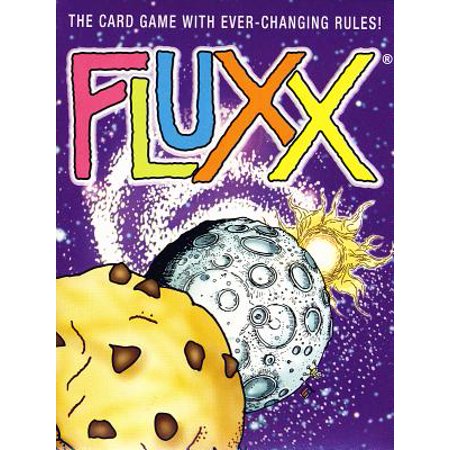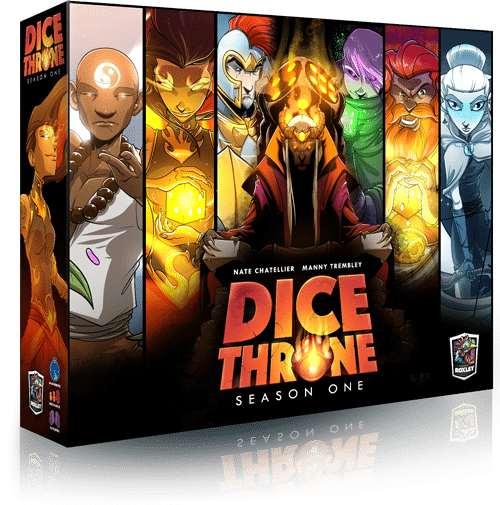This past weekend I hosted a retreat for 6th through 8th graders at a camp where primarily outdoor activities were planned. The only problem was thunderstorms were on the docket for 100% of the time we were supposed to enjoy said outdoor activities.
No bueno.

Anticipating (and fearing) a weekend indoors with a bunch of middle schoolers, I snagged a handful of games from my collection that I considered easy to teach and play. Among them was Fluxx, which grabbed my junior high boys’ attention.
I’d hoped to give the boys a quick rundown of how the game is played, then slip over to teach the girls a game or two, as well. I explained that in Fluxx you read and follow any face-up Rule cards on your turn while trying to match Keepers to the Goal card. When you play a card, you just do exactly what it says (if anything).
Easy peasy.
Only it wasn’t, really. Every face showed confusion as I rounded up a few of the other games intent on leaving them to the game and dropping in on the ladies. Luckily, I thought better of it and properly taught and played the game with them.
It struck me afterwards that the way I taught them (and the way I teach pretty much all tabletop games) closely resembles what some call The 5 Stages of Leadership. Here are those stages and how they apply to teaching tabletop games:
1. I Do It, You Watch.
I read my way through the rulebook while stopping to clarify components and interactions visually.
It just isn’t efficient to pass the rulebook around for all to read ahead of a play, so I’m definitely in a Master Teacher role here. Occasionally I’ll even do the whole Kindergarten-teacher-showing-the-pictures-in-the-book-to-the-whole-class thing. You know the one!
Some folks are primarily visual learners, and the ones who aren’t don’t suffer for sitting through visual aids or demonstrations.
Best practice here: If possible, read the rulebook ahead of time (or have a pre-existing familiarity with the game you’re teaching) because a dry read through of a rulebook is nobody’s jam. This lets you simplify and even combine the explanation of gameplay concepts as you teach them.
For the boys learning Fluxx, I showed them examples of every card type, where they’re played (Action cards to the discard pile; pretty much everything else on the table either before you [Keepers, Creepers] or accessible to all [Rules]), and emphasized reading everything on every card.
2. I do it, you help.
I create a quick scenarios relevant to the gameplay and ask those learning to tell me what I can do.
This helps me gauge how well the learners grasped what they took in during Step 1. I can quickly assess which, if any, of the concepts they’re still unclear on and address them ahead of the actual gameplay.
If you equate this to a standard video game tutorial, Step 1 is the text or speech that tells you what to do (eg “Look around using the left joystick”), and Step 2 is you proving you can perform the required task which allows you to progress.
If you don’t move that joystick, the game sits in a static state. It stalls. When this happens during actual gameplay, it can be a bummer and a bore. Head that off as best you can with quick showcases–which are also consequence free! If they goof, they learn without tanking their chances at a W.
I showed the boys my handful of cards and asked what my possible plays were, and then I tossed down a few extra Rule cards and asked the same question with the same hand. Lightbulbs started to go off!
3. You do it, I help.
This step typically encompasses the entire first play of the game. We’re beyond scenarios; we’re each taking our turns and trying to win!
Now we play! I will walk the table verbally through every action I take on my turn (and I usually go first for this very reason) and will even do the same thing on their turn. I am still actively teaching as we play – speaking aloud their options as I see them, even if they hurt my chances of winning.
After a few turns, I’ll quiet down but remain open to questions and requests for help.
The first few turns in Fluxx were me saying “Draw one and play one” until new Rules were added and Keepers, Creepers, and Goals hit the table. By this time, they’d learned enough that they were able to explain everything as they played without my input. They were talking themselves through their own turns; growing up right before my eyes!
4. You do it, I watch.
All other subsequent plays fall under this step, and take one of two forms:
- We play the game and you’re on your own (no more help from me!), or
- You play the game with others and I monitor to make sure no rules go forgotten or misunderstood/misapplied (if I monitor at all).
I’ve hopefully worked myself out of a job by this point. I might clarify a fiddly thing here or there, but we’re legitimately playing the game now, and it is a wonderful thing.
It’s not like I won’t answer questions and whatnot at this stage, but the idea is that the work I put in earlier minimizes that need.

We never got a second game of Fluxx in, but I also taught them Dice Throne using the same method, and a few of the boys took it aside on their own and played. I was not needed! I checked in with them later to see who’d won and they talked about who’d had what status effects and who rolled their supers…It was glorious!
One of my adult volunteers even mentioned to me that I must be proud to have taught them to play a game that I love. He wasn’t wrong.
5. You do it, someone else watches.
This is maybe my favorite step: Seeing you excitedly teach another how to play the game!
This hasn’t happened yet, but those boys will undoubtedly ask me to bring Fluxx and/or Dice Throne to the next retreat and when I ask if they need me to help them teach it, they’ll confidently say they’ve got it and run off to indoctrinate teach some of the others.
That, or they’ll challenge me to the game like I’m the final boss!
Either way, I’ll be a proud pseudo-dad.
When you think about it, leading a game and teaching a game are very similar things, so it makes sense how well The 5 Stages of Leadership fit my approach to teaching.
Most of the time I’ll combine Steps 1 and 2 so that they’re more organic and not quite so distinct, and if I’m playing with competent folks Step 3 morphs into Step 4 during the course of a single play through instead of across two or more. There is definitely some flexibility to the process!
We’ve also got a post on how to teach younger kids heavier tabletop games that pairs nicely with this one!

